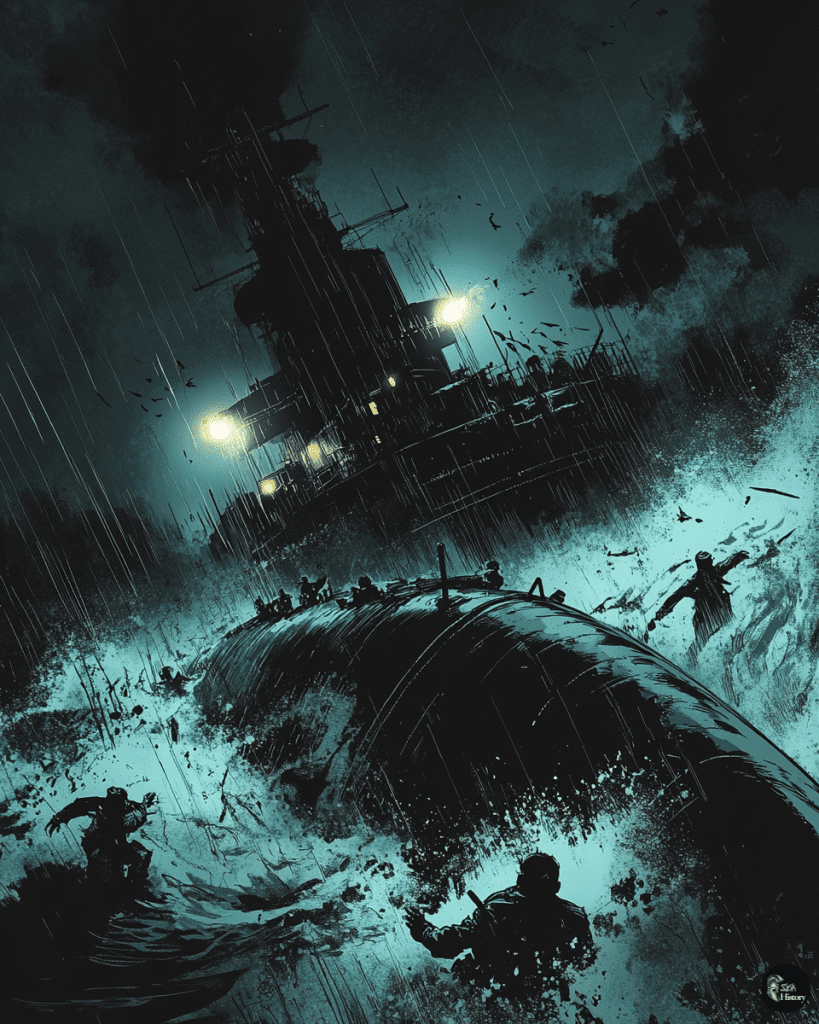The “Battle” of May Island was not a battle at all but a tragic series of accidents involving Royal Navy vessels on the night of January 31-February 1, 1918. This disastrous event occurred in the Firth of Forth near the Isle of May as a large fleet departed Rosyth for exercises in the North Sea.
The incident resulted in the loss of two K-class submarines and the deaths of over 100 British sailors, marking one of the Royal Navy’s worst peacetime disasters.
The K-class submarines, innovative yet problematic vessels designed to keep pace with the Grand Fleet, played a central role in the tragedy.
These steam-powered submarines could reach speeds of 24 knots on the surface but were notoriously tricky to handle.
As two flotillas of K-class submarines maneuvered in the darkness, a series of collisions unfolded, involving not only submarines but also cruisers and destroyers.
The Fateful Voyage of the K-Class Submarines
The K-Class submarines’ ill-fated journey in 1918 became a defining moment in Royal Navy history, marked by a series of tragic collisions and sinkings. This disastrous expedition highlighted the inherent flaws of these steam-powered vessels and their unsuitability for naval operations.
Tragedy in the North Sea
The Battle of May Island unfolded on a dark January night in 1918.
As the Grand Fleet set sail from Rosyth for exercises in the North Sea, the K-Class submarines joined the procession. These vessels, designed to keep pace with surface ships, proved challenging to maneuver in the crowded waters of the Firth of Forth.
The darkness and confusion led to a series of collisions.
K14 suddenly lost steering, causing K22 to crash into her. The impact was severe, leaving both submarines damaged and struggling to stay afloat.
As other vessels attempted to assist, the situation deteriorated rapidly. HMS Fearless, a light cruiser, collided with K17 at near full speed. The submarine sank within minutes, its crew barely managing to escape into the frigid waters.
The Royal Navy’s Submarine Squadrons
The K-Class submarines were part of the Royal Navy’s ambitious plan to create a fleet of fast, steam-powered underwater vessels.
These submarines were organized into flotillas, each consisting of several boats designed to operate alongside the surface fleet.
The 12th and 13th Submarine Flotillas were involved in the May Island incident. During fleet exercises, these squadrons were tasked with accompanying battlecruisers and other surface vessels.
K-Class submarines were unique in their design. They featured steam propulsion, which allowed them to achieve speeds of up to 24 knots on the surface. However, this innovative approach had significant drawbacks, including complex machinery and increased vulnerability when submerged.
Chronicle of Missteps: The Timeline of Collisions
8:32 PM: K14 experiences steering problems, veering off course.
8:35 PM: K22 collides with K14, causing significant damage to both vessels.
8:40 PM: HMS Fearless strikes K17, leading to its rapid sinking.
9:00 PM: K4 rams K6, further adding to the chaos.
Throughout the night, rescue efforts were hampered by darkness and confusion. The collisions resulted in the loss of K17 and K4, with numerous crew casualties.
Aftermath and Legacy
The Battle of May Island had far-reaching consequences for the Royal Navy. The aftermath of this tragic event led to a thorough military investigation. The incident exposed the limitations of the K-Class design and raised questions about the Royal Navy’s training and operational procedures for these complex vessels.
Investigations and Court Martial Proceedings
The Royal Navy launched immediate investigations into the tragic events of January 31, 1918.
Multiple court martial proceedings were held to determine responsibility for the collisions and sinkings. Officers and crew members involved in the incident faced questioning about their actions and decisions during the ill-fated exercise.
The proceedings revealed a series of miscommunications, poor visibility, and mechanical failures that contributed to the disaster.
Several officers were reprimanded, while others were cleared of wrongdoing. The courts-martial highlighted the need for improved communication systems and better coordination during fleet maneuvers.
Implications for Naval Strategy and Submarine Design
The Battle of May Island profoundly affected submarine design and naval tactics.
The K-class submarines, once hailed for their speed and endurance, came under intense scrutiny. Naval engineers recognized the need for more maneuverable and reliable submarine designs.
The incident prompted a reevaluation of large-scale fleet exercises, especially those conducted at night or in poor visibility.
The Royal Navy implemented stricter safety protocols and improved signaling systems to prevent similar accidents in the future.
The steam-propelled K-class submarines were gradually phased out in favor of more advanced diesel-electric designs. This shift marked a significant turning point in submarine technology and naval warfare strategy.
Preserving the Memory of the May Island Incident
Efforts to commemorate the Battle of May Island have continued over the years.
Marine archaeologists have studied the wreck sites, providing new insights into the disaster.
In recent years, underwater surveys have revealed previously unknown details about the K-class submarines and their fate.
Memorial services are held periodically to honor the lives lost during the incident.
These events serve as a reminder of the risks faced by submariners and the importance of naval safety.
The Battle of May Island remains a poignant chapter in Royal Navy history, offering valuable lessons for future generations of sailors and naval strategists.

